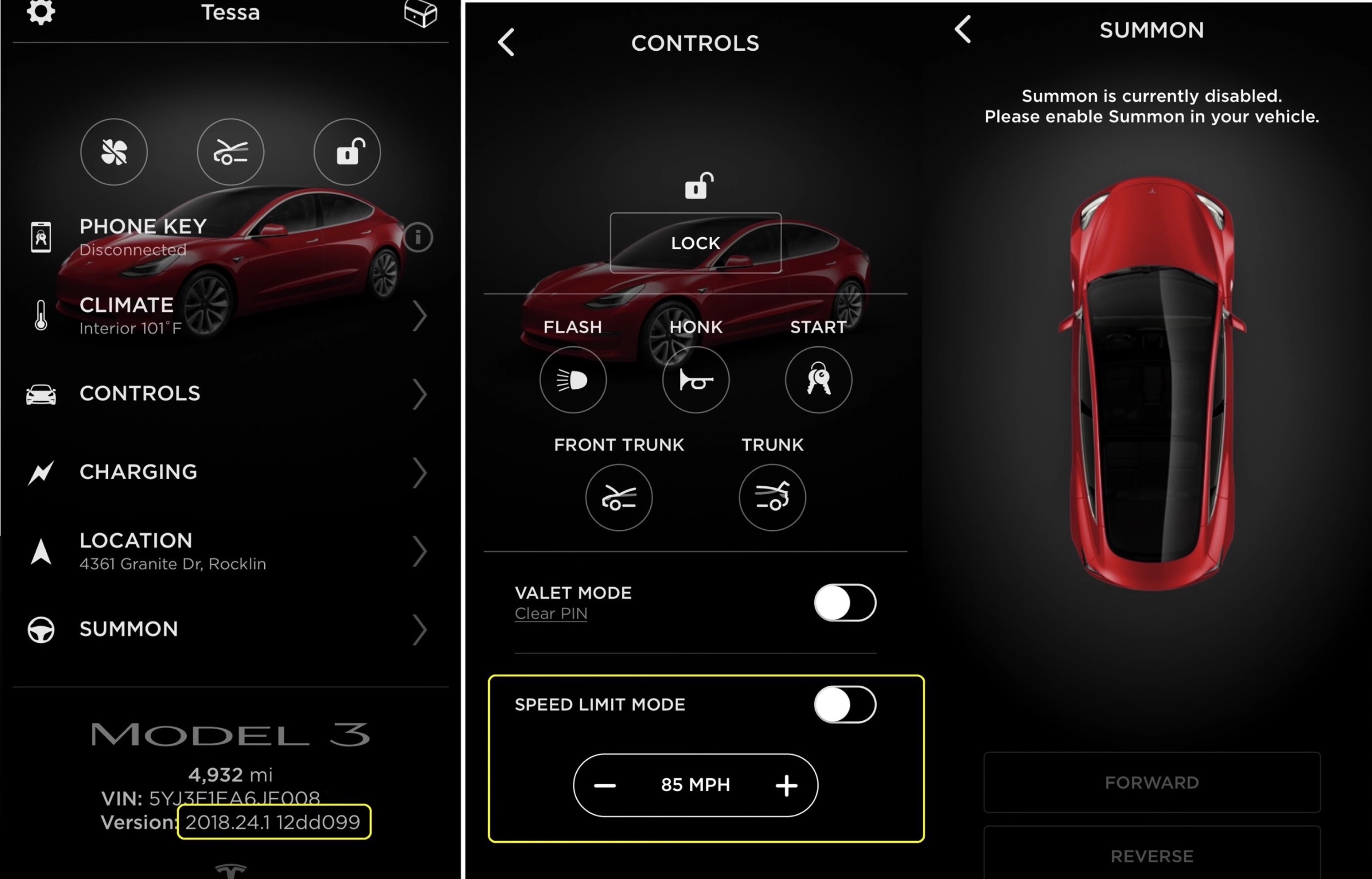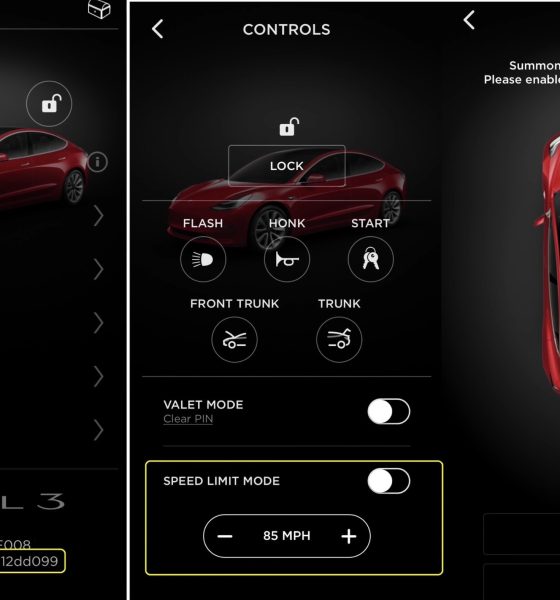

Lifestyle
Closer look at Tesla Model 3 Speed Limit Mode and Summon in mobile app
Tesla’s recent software update, v8.1(2018.24.1), introduced a number of new features for the Model 3, including Summon, cabin overheat protection, WiFi connectivity, and the ability to set speed limits on the vehicle.
Tesla enthusiast and Model 3 owner Ivan Karpenko recently shared a short walkthrough on how these features are accessed and adjusted through the Tesla mobile app. As could be seen in the video, setting the speed limits for the compact electric car on the mobile app is as simple as navigating to the Controls menu and scrolling down to Speed Limit Mode, which is located underneath Valet Mode. Speed Limit Mode is activated by tapping on a button and keying in a 4-digit PIN. Setting the maximum speed of the vehicle is just a matter of tapping or long-pressing the “+” and “-” symbols on the app.
Summon, on the other hand, is accessed by scrolling down the list of menus on the Tesla app and selecting the feature. In the mobile app’s current version, Summon is placed directly below Location. Tapping on Summon takes users into a menu displaying the Model 3, and if the feature had been activated in the vehicle, drivers would be able to command the car to move forward or in reverse.
Tesla’s new features for the Model 3 are focused on safety. Cabin overheat protection, which is enabled on Tesla’s electric cars by default, is a means to proactively prevent instances when children or animals get too hot when left inside the vehicle. Child fatalities resulting from in-car heat strokes is are severe problem in the United States. Last July 2017 alone, America saw 31 child fatalities — a record high at the time — resulting from heat strokes after children were left in a parked car.
Also notable in the Model 3’s recent updates is the Speed Limit Mode, which places limiters on the vehicles’ acceleration and maximum speed. Speed Limit Mode is described by Tesla as follows.
“Speed Limit Mode – This feature limits the acceleration of your vehicle and allows you to set a maximum speed limit between 50 mph and 90 mph. While your car is in Park, you can activate Speed Limit Mode by tapping Controls > Safety & Security on the touchscreen or by tapping CONTROLS on the mobile app. You must use the same 4-digit PIN to enable or disable Speed Limit Mode. A notification is sent to your mobile device is your vehicle approaches the set maximum speed. — In memory of Barrett Riley.”
Barrett Riley, 18, lost his life in a fiery accident after driving his Model S at speeds of 116 mph in a 30 mph zone, according to a Sun-Sentinel report. One of Barrett’s passengers, 18-year-old Edgar Monserratt Martinez, was also killed in the crash. In its investigation into the accident, the NTSB noted that the electric car was traveling at 116 mph three seconds before impact, slowing to 108 mph as the driver applied the brakes, and decreasing to 86 mph as it hit a wall.
After Barrett was cited for overspeeding last March, his father asked Tesla to adjust the vehicle’s speed through an over-the-air adjustment. Speed adjustments, after all, are already being implemented on loaner vehicles, which are limited to 85 mph. Based on the release notes of Tesla’s recent software update, it seems like Mr. Barrett’s requested feature can now help make Tesla’s fleet even safer.
Watch a brief walkthrough of the Model 3’s Speed Limit Mode and Summon in the Tesla mobile app below.

Lifestyle
Tesla Model S Plaid battles China’s 1500 hp monster Nurburgring monster, with surprising results
There is just something about Tesla’s tuning and refinement that makes raw specs seem not as game-changing.

The Tesla Model S Plaid has been around for some time. Today, it is no longer the world’s quickest four-door electric sedan, nor is it the most powerful. As per a recent video from motoring YouTube channel Carwow, however, it seems like the Model S Plaid is still more than a match for some of its newer and more powerful rivals.
The monster from China
The Xiaomi SU7 Ultra is nothing short of a monster. Just like the Model S Plaid, it features three motors. It also has 1,548 hp and 1,770 Nm of torque. It’s All Wheel Drive and weighs a hefty 2,360 kg. The vehicle, which costs just about the equivalent of £55,000, has been recorded setting an insane 7:04.957 at the Nurburgring, surpassing the previous record held by the Porsche Taycan Turbo GT.
For all intents and purposes, the Model S Plaid looked outgunned in Carwow’s test. The Model S Plaid is no slouch with its three motors that produce 1,020 hp and 1,420 Nm of torque. It’s also a bit lighter at 2,190 kg despite its larger size. However, as the Carwow host pointed out, the Model S Plaid holds a 7:25.231 record in the Nurburgring. Compared to the Xiaomi SU7 Ultra’s record, the Model S Plaid’s lap time is notably slower.
Real-world tests
As could be seen in Carwow’s drag races, however, Tesla’s tech wizardry with the Model S Plaid is still hard to beat. The two vehicles competed in nine races, and the older Model S Plaid actually beat its newer, more powerful counterpart from China several times. At one point in the race, the Xiaomi SU7 Ultra hit its power limit due to its battery’s temperature, but the Model S Plaid was still going strong.
The Model S Plaid was first teased five years ago, in September 2020 during Tesla’s Battery Day. Since then, cars like the Lucid Air Sapphire and the Xiaomi SU7 Ultra have been released, surpassing its specs. But just like the Model Y ended up being the better all-rounder compared to the BYD Sealion 7 and the MG IM6, there is just something about Tesla’s tuning and refinement that makes raw specs seem not as game-changing.
Check out Carwow’s Model S Plaid vs Xiaomi SU7 drag race video below.
Lifestyle
500-mile test proves why Tesla Model Y still humiliates rivals in Europe
On paper, the BYD Sealion 7 and MG IM6 promised standout capabilities against the Model Y.

BYD is seeing a lot of momentum in Europe, so much so that mainstream media has taken every opportunity to argue that the Chinese automaker has beaten Tesla in the region. But while BYD sales this year in Europe are rising and Tesla’s registrations remain challenged, the raw capabilities of vehicles like the Model Y are difficult to deny.
This was highlighted in a 500-mile challenge by What Car? magazine, which showed that the new Tesla Model Y is more efficient, cheaper to run, and more reliable than rivals like the BYD Sealion 7, and even the nearly 400 KW-charging MG IM6.
Range and charging promises
On paper, the BYD Sealion 7 and MG IM6 promised standout capabilities against the Model Y. The Sealion 7 had more estimated range and the IM6 promised significantly faster charging. When faced with real-world conditions, however, it was still the Model Y that proved superior.
During the 500-mile test, the BYD nearly failed to reach a charging stop, arriving with less range than its display projected, as noted in a CarUp report. MG fared better, but its charging speeds never reached its promised nearly-400 kW charging speed. Tesla’s Model Y, by comparison, managed energy calculations precisely and arrived at each stop without issue.
Tesla leads in areas that matter
Charging times from 25% to 80% showed that the MG was the fastest at 17 minutes, while Tesla and BYD were close at 28 and 29 minutes, respectively. Overall efficiency and cost told a different story, however. The Model Y consumed 19.4 kWh per 100 km, compared to 22.2 for MG and 23.9 for BYD. Over the full trip, Tesla’s charging costs totaled just £82 thanks to its supercharger network, far below BYD’s £130 and MG’s £119.
What Car? Magazine’s testers concluded that despite BYD’s rapid sales growth and the MG IM6’s seriously impressive charging speeds, Tesla remains the more compelling real-world choice. The Model Y just offers stability, efficiency, and a proven charging infrastructure through its Supercharging network. And as per the magazine’s hosts, the Model Y is even the cheapest car to own among the three that were tested.
Watch What Car? Magazine’s 500-mile test in the video below.
Lifestyle
Tesla Cybertruck slapped with world’s least intimidating ticket, and it’s pure cringe
One cannot help but cringe and feel second-hand embarrassment at the idea of a person just driving around with a stack of these babies.

A Cybertruck parked at Stanford Shopping Center in California was recently hit with what might be the most try-hard piece of paper ever slipped under a wiper blade: a “fake citation” accusing the driver of supporting a “fascist car.”
The note, shared on X by Tesla staff program manager Ryan Torres, quickly made the rounds on X, where it quickly gained attention as an example of how not to protest.
The world’s least intimidating ticket
According to the citation, the supposed “violation” was “driving a fascist car.” The remedial action? Take the bus, call an Uber, or ride a bike. The note also dubbed Elon Musk a “chainsaw-wielding Nazi billionaire.” Now, protests against Tesla and Elon Musk have become commonplace this year, but one cannot help but cringe and feel second-hand embarrassment at the idea of a person just driving around with a stack of fake anti-Tesla/Musk citations.
Torres pointed out the irony himself in his post on X. Tesla currently employs over 140,000 Americans, and SpaceX has put the U.S. firmly back at the top of space technology. As Torres put it, maybe the person behind the world’s least intimidating ticket should “read a book on innovation before vandalizing” other people’s property.
Peak performative clownery
Not to mention that the fake ticket’s logic collapses under its own weight. EVs like the Cybertruck are literally designed to reduce emissions, not “destroy the economy.” If anything, Tesla has bolstered the United States’ economy by fueling jobs in engineering, manufacturing, and clean energy. It’s not the first time a Tesla has been the target of vandalism or politically charged notes, but this one stands out for sheer cringe value.
Torres summed it up neatly: “Peak clownery.” On that point, at least, the citation earns full marks. In a way, though, perhaps cringe fake tickets are not as bad as the literal firebombs that were being thrown at Tesla stores and cars earlier this year because some critics were gleefully misinformed about Elon Musk.








